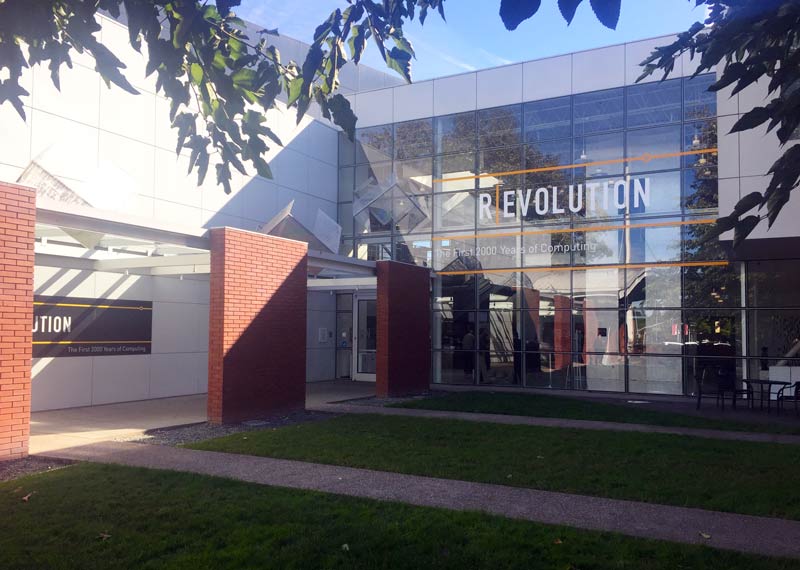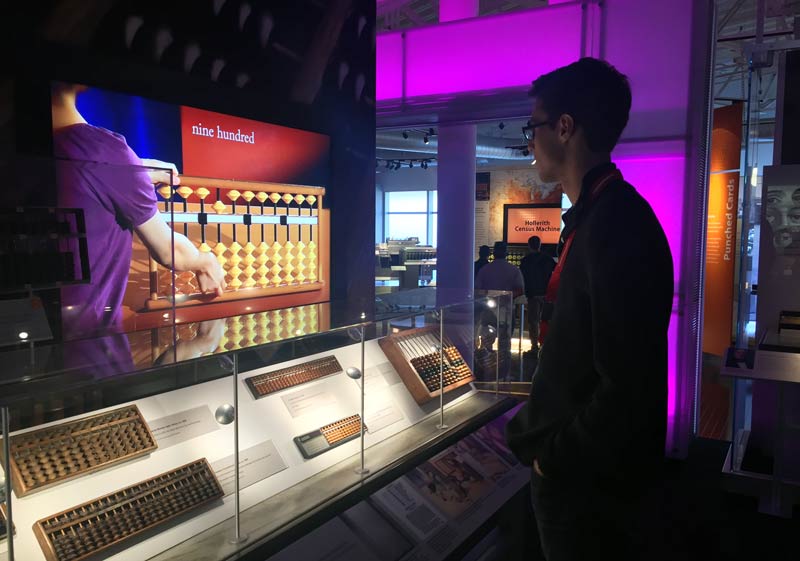Sigma Pi Sigma Physics Congress (PhysCon)
November 3, 2016 to November 5, 2016
San Francisco, CA
Meeting host: By:Tara Skiba and Louis Varriano
SPS Chapter:

PhysCon attendees had the opportunity to tour the Computer History Museum, a museum dedicated to the collection, preservation, and display of artifacts from the history of computers. The museum explores not only the history of development of computers but also examines the continuing impact that computers play in the modern world. Jesse Nichols, a tour guide at the Computer History Museum for more than four years, explained, “The goal of the museum is to show where it came from all, not just to focus on new technology.”
Nichols is right. The museum really does focus on the long and complicated history of the computers that we know today. The museum is divided into 19 main galleries and 3 special exhibits, containing thousands of artifacts, images, videos, and other multimedia displays. The first two galleries explored predecessors to analog computers. The many different techniques that people first developed to aid in addition and multiplication were on display, including the abacus, the slide rule, and Napier’s bones (a sort of multiplication table). Several of these devices even proved challenging to use for current physics undergraduates!
The two-thousand-year history from the abacus to the punch card reader shows how society developed calculating devices to meet its needs. Punch cards were a primitive form of programming; instead of storing data electronically, data was instead stored physically on paper cards by punching holes in a specific order. As the museum showed, punch card readers were an essential component in the rollout of the Social Security program in the 1930s. Students were even able to make their own punch cards! We had a great time converting our names into the appropriate punch holes and kept the cards as souvenirs. Obviously, however, we far prefer just typing on a keyboard or using our phones. If Twitter users had to hole-punch their Tweets, we’re fairly certain the medium would be much less popular.
Then we moved into an exhibit showing computers that were used during World War II. World War II precipitated many of the advances in computing by pouring money and time into creating systems that could encrypt and crack codes as well as navigate ships and missiles. We saw two well-known examples of the need for computers during war: an Enigma machine used by the Germans to encrypt messages, and the Colossus machine which was developed in secret by the Allies to break the encryption. It was sobering to reflect on the many uses that technology has, both noble and nefarious. As physics students, it was clear that future discoveries can have dubious ethical implications.

Perhaps the most relevant gallery for physics students showed the advancement of supercomputers. Students particularly took note of the CRAY models of supercomputers, from the innovatively-designed CRAY-1, to the failure of CRAY-3 due to its unreliable gallium-arsenide electronics. Supercomputers play such an important role in modern physics research that it was very interesting for us to see the ancestors of the machines in use today.
We also enjoyed the exhibit that showed the beginnings of mass commercialization of computers, which occurred during the middle of the twentieth century. One of the more humorous examples was the Honeywell Kitchen Computer, available in Neiman-Marcus stores in 1969. The main selling point of this computer, advertised for $10,000 ($78,000 in today’s money), was its ability to store recipes, in addition to the included two-week programming course. However, without a monitor to display the recipes in text form, its usefulness was severely lessened. No Kitchen Computers were ever sold, despite the advantage of a built-in cutting board.
We also learned about the early days of Microsoft and Apple and the first computer games, like Spacewar!, first created for the PDP-1 computer. Gaming consoles from the 1980s onwards were on display, as well as several functioning games! SPS students played Pong against each other and attempted to help Pac-Man eat a screen full of dots (without much luck).
The galleries ended by exploring the continuing role that computers play in our lives and the possibility for future technological developments. A special exhibit took a much closer look at the applications of computers in the future – self-driving cars! A self-driving car from Google was on display, with a notably absent steering wheel. Self-driving cars are an important example of the application of physics to improving society, as many technologies from physics research are used to allow the car to move on its own; examples include LIDAR, lasers, and cameras. Physics students were able to relate not only to the cool, new technology, but also to how their studies and research can impact society broadly.
The Computer History Museum emphasized not only the development of computers but also humanity’s relationship with computers.
By focusing on the history of the computer, the museum educated its visitors about the decades of hard work that researchers and scientists—including physicists—went through to produce the computers that we use today. Even we physics students, who are often very familiar (perhaps even overexposed) to computers, felt like we gained a deeper understanding about their usefulness and importance throughout history.